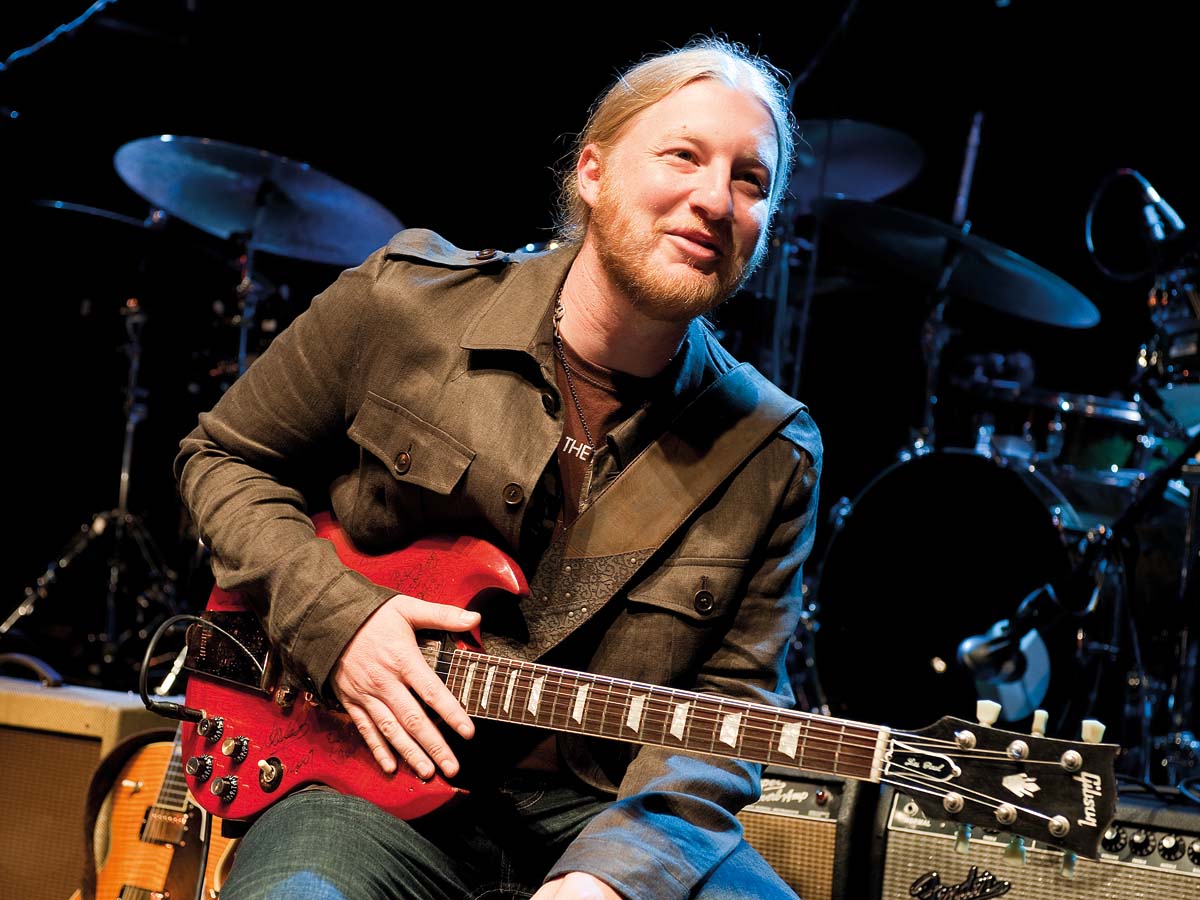40 guitarists who changed our world since 1980
The players who revolutionized guitar technique and tone over the past 40 years
21. Kaki King
WHAT SHE DID: This acoustic trailblazer took her Preston Reed influences to otherworldly new places in the early to mid 2000s – and he hasn’t stopped evolving since. King, who was one of only a handful of women in the dude-dominated guitar scene at the time, is one of the main influences behind the incredible recent rise in population of female guitarists.
I don’t have a memory of not knowing how to play guitar, and now my career is completely associated with this instrument and it becomes a question of self-identity
Kaki King
In late 2007, Foo Fighter Dave Grohl famously announced, “There are some guitar players that are good and there are some guitar players that are really fucking good. And then there’s Kaki King.”
It’s that very aspect of King being “a thing unto herself” – fans often say she invented her very own genre – that makes her so unique, so revered. Since her debut album, 2003’s Everybody Loves You, her delicate fingerstyle approach, effortless tap-style polyrhythms and wild open tunings have been turning heads around the world.
“I think the main challenge for me was exploring some new tunings,” she said in 2012. “I’ve always used a lot of open tunings [including CGDGAD and DADGAD], but it becomes the kind of thing where you get familiar with them. It becomes too easy to improvise with them. But when I started using open D minor tuning, that immediately opened some new doors for me.”
As for that Dave Grohl quote?
“That was a pretty funny and amazing thing,” she said, recalling the onstage props. “By that point, I kind of knew Dave, so it was a lovely, fun, typically over-the-top comment from a friend. It wasn’t like this rock god deemed me brilliant, but at the same time, it was a sincere compliment from a really nice guy. I was very touched.”
22. Billy Corgan
I’m trying to figure out how to take the instrument and have it still sound like a guitar, but put you in a different universe
Billy Corgan
WHAT HE DID: A one-man guitar-and-bass army responsible for some of the Nineties’ most iconic rock songs, including 1979, Disarm, Tonight, Tonight and Bullet with Butterfly Wings.
Get The Pick Newsletter
All the latest guitar news, interviews, lessons, reviews, deals and more, direct to your inbox!
Nineties rock guitar began with a tug-of-war between shred and grunge, but Billy Corgan found a unique solution to the conflict. The hulking Smashing Pumpkins frontman and chief songwriter dabbled in both styles, and then some.
Corgan created guitar armadas, placing up to 40 guitar overdubs on a single track. These stuck out in an alternative scene that was competing to make the most lo-fi album. The Pumpkins’ defiantly massive orchestrations were inspired by the shoegaze scene and unfashionable pomp rockers like Queen and Boston.
He fully harnessed the Big Muff fuzz’s potential to create a wall of noise, and like his heroes Cheap Trick, created a sound that was equal parts rock fury and pop magic. When metal was a dirty word, Corgan embraced Sabbath and Van Halen, revealing an artist always unafraid to be himself.
23. Derek Trucks

WHAT HE DID: Slide-guitar prodigy whose skills are stunning, and stunningly diverse. Through his playing with the Allman Brothers Band, the Derek Trucks Band and the Tedeschi Trucks Band, the group he shares with his wife Susan Tedeschi, Trucks has consistently proven to be a fountain of effortlessly fluid, microtonal-specked lines that glide and soar with vocal-like grace and an inspiration to slide guitarists everywhere.
No one’s ever taken slide guitar all the way, which is why I was drawn to it
Derek Trucks
Derek Truck's reputation as a slide guitar master should be without question to anyone who has been watching his very public development for the better part of two decades. The Florida native has been touring since he was 11, released his first album when he was 17 and joined the Allman Brothers Band when he was 19.
Now 41, Trucks is an endlessly inspired and crafty guitarist, equally capable of playing tasty, minimalist fills or extended improvised solos that never fail to surprise. Always tuned to open E and never using a pick, Trucks has established a wholly individual sound, incorporating Indian classical music, “sacred steel” gospel and jazz into a more classic, blues-rock base.
24. Billy Gibbons
WHAT HE DID: With ZZ Top, Gibbons stole the blues back from British rockers with a vengeance during the Seventies and in the mid Eighties combined his nitro-fueled guitar playing with danceable drum-machine beats and pulsing synth bass lines, beating like-minded industrial artists to the dance floor by several years.
The blues deals with the highest of highs, the lowest of lows and all points in between
Billy Gibbons
By 1983, ZZ Top had long since established themselves as the greatest little blues rock trio ever to come out of Texas, as well as men who would go to great lengths to cultivate their facial hair.
But with the Eighties’ new wave booming, guitarist and conceptualist Billy F. Gibbons reinvented the trio as a blues band from outer space, and one with unabashed pop leanings. Eliminator classics Gimmie All Your Lovin’, Sharp Dressed Man and Legs combined savvy songcraft with a paint-peeling guitar tone, reportedly recorded direct through a tiny Rockman preamp.
When it comes to using a slide, the eccentric Texan says, “I’ve managed to learn to hold the slide with my middle finger. A lot of players believe it belongs on the pinkie or the ring finger. I prefer the middle, it leaves the other three digits free to do what you want. You can even play chords that way.
“The main thing is training to only follow where you get the proper pitch. You can’t play in between the frets, you need to actually be on them. That’s a critical move. If you go between the lines, you’re actually going out of pitch.”
25. Thurston Moore & Lee Ranaldo (Sonic Youth)
WHAT THEY DID: Their unusual tunings, bold harmonic experimentation and pioneering application of noise and textures made Sonic Youth’s Lee Ranaldo and Thurston Moore the godfathers of alternative guitar.
We felt very liberated in the early Eighties because suddenly it was okay to be interested in anything rather than having to have that ‘punk rules, everything else sucks’ mentality
Thurston Moore
Sonic Youth set the pattern for how an Eighties indie band could grow in popularity without losing credibility.
Co-guitarists Thurston Moore and Lee Ranaldo combined punk rock attitude and song structure with open tuning techniques developed by downtown Manhattan avant-garde guitar composers Glenn Branca and Rys Chatham, and invented one of the most radical approaches to guitar in the history of rock.
They reawakened interest in Fender Jaguars and Jazzmasters and motivated guitarists of every stripe to venture beyond standard tuning, profoundly affecting the sound of rock in the Nineties.
26. Jack White
WHAT HE DID: Spearheaded the garage rock revival of the 2000s with his two-piece band the White Stripes and raucous rock hits like Fell in Love with a Girl, Dead Leaves and the Dirty Ground and Seven Nation Army.
Rock and roll isn’t really known for its great examples of human decency
Jack White
THE youngest of 10 children, Jack White – born Jack Gillis in 1975 – grew up in a gritty Detroit, Michigan, neighborhood and worked as an assistant upholsterer after graduating high school. It was during this rather humble period that White got serious about his music.
He immersed himself in the primitive sounds of the Detroit garage rock revival, playing drums and guitar in several bands while privately forming a very focused musical aesthetic. The turning point came in 1996 when he married Meg White and began teaching her how to play drums.
“We were just messing around, kind of as a joke, but it ended up being perfect. She played like such a child,” White says of Meg, who is now his ex-wife, “and the sound was something fresh.” And so the concept of the White Stripes was born, inspired in equal parts by the unvarnished music of the Delta blues, Dutch minimalist art and Meg’s naïve drumming.
The results were so original and uncompromising that soon the whole alternative rock world stood up and took notice for much of the early 2000s. Seven Nation Army, one of the biggest songs of that period, saw White’s guitar tuned to open A. You can play the mega-easy verse riff in any tuning, really – it’s in the chorus where open A comes into its own. Those slide guitar lines wouldn’t be possible in standard tuning.
27. Tosin Abasi

WHAT HE DID: With his eight-string guitar and virtuoso shred abilities, the Animals as Leaders guitarist has been at metalcore’s cutting edge since 2009.
For me, the eight-string and its almost alien quality started to produce new musical ideas because it was un-guitar-like in a lot of ways
Tosin Abasi
Animals as Leaders’ widely hailed self-titled 2009 debut was a dazzling instrumental showcase that featured Tosin Abasi’s innovative seven- and eight-string guitar playing.
Packed with wickedly fast soloing, beautiful jazz-influenced chord voicings and tricky polyrhythms, Animals as Leaders put Abasi on the short list of post-millennial shredders that really matter.
Abasi’s eight-string guitars – formerly his Ibanez signature models, and now his own Abasi Larada guitars – have become his stock in trade, sleek-bodied instruments with broad, massive necks that carry the heft and menace of weaponry.
And indeed Abasi uses these guitars to devastating effect on the four albums he’s recorded as the mastermind of Animals as Leaders, post-thrash, prog-metal exponents of a brawny, blindingly virtuosic style of instrumental guitar rock called djent.
The genre name is an onomatopoetic nod to the sound of a palm-muted downstroke on ultralow, hyperdistorted guitar strings. And nobody lays that sound down quite like Abasi.
28. Dimebag Darrell
WHAT HE DID: An unapologetic shredder who kept the art of the guitar solo alive and well during the Nineties – when grunge, alternative and hip-hop-inspired, rhythm-based “nu-metal” dominated the charts – Dimebag provided welcome relief for players who wanted to push the boundaries instead of wallow in mediocrity.
Heavy metal is what I’m into. Shit that moves you. Shit that has heart and soul
Dimebag Darrell
Dimebag was of the most influential metal guitarists of the past 30 years, with a sound, style and look as outsized as his legendary personality. His ferocious lead technique on such albums as 1990’s Cowboys from Hell and 1992’s Vulgar Display of Power was a full-frontal assault that drew as heavily on blues as heavy metal.
His penchant for the lead work of rock and metal giants such as Eddie Van Halen and Randy Rhoads was combined with his own unique take on the humble pentatonic scale.
Although favoring extreme techniques such as wide, aggressive vibrato, whammy bar antics and huge squealing harmonics, Dimebag was always in control of his sound; no mean feat when dealing with large amounts of distortion and boosted treble.
He initially favored tuning to an “in between” point roughly 0.6 of a semitone below standard tuning. Later on, he used D standard (DGCFAD) and drop C (CGCFA), which allowed wider bends and more aggressive vibrato in his lead playing.
29. Glenn Tipton & K.K. Downing (Judas Priest)
WHAT THEY DID: From 1974 to 2011, the team of Tipton and band co-founder Downing led the heavy metal brigade, introducing a twin-guitar attack to the genre, defining a sound rooted in power chords, palm muting and back-and-forth lead breaks that inspired generations of groups, from Iron Maiden to Slayer.
I don’t ever want to compromise Judas Priest. It’s too big a part of my life
Glenn Tipton
For 37 years, Glenn Tipton and K.K. Downing were the Judas Priest members that were primarily responsible for forging the band’s sound, playing together so fluidly that the phrase “the patented twin-guitar leads of Tipton and Downing” has long been seared across the frontal lobes of rock scribes everywhere.
Their partnership began in 1974 in Birmingham, England, when Judas Priest (then consisting of Halford, Downing, bassist Ian Hill and drummer John Hinch) decided to add a guitarist on the eve of recording their first album, Rocka Rolla.
“I was in the Flying Hat Band,” Tipton told Guitar World. “We were sort of in slight competition with Priest at the time; it was a sort of local band rivalry. Priest picked up a record contract with Gull Records, and they felt inclined to give the band more strength. I think they’d considered a keyboard player, but they approached me and asked would I be interested in joining.
“My group had had a few problems with management and things, so I thought, I’ll join Priest for a bit until I can do something else.” He laughs. “But once I joined, it didn’t take me more than a millisecond to realize the potential of the band.”
Judas Priest are the originators of the molten metal, two-guitar arsenal
Dimebag Darrell
Judas Priest spent the rest of the Seventies issuing various records in a frenetic charge to capture the heavy metal crown, and finally broke through in the U.S. in 1980 with the release of British Steel.
With its perfect blend of crunching, scalpel-sharp riffs and bracing leads that are part hummable melody, part blazing forest fire, British Steel is a textbook example of the sound that defined the New Wave of British Heavy Metal – a subgenre that balances savage aggression with tight, memorable riffs.
Many consider it to be Judas Priest’s defining moment. It also awakened a new generation of musicians to the creative potential of crushing guitar riffs and gritty melodies. For example, when Slayer started out in 1981, they performed countless Judas Priest covers before creating their own sound by combining Priest’s firepower with the tempos of Motörhead and the attitude of hardcore.
Pantera, for their part, crossed the full-fisted crunch of British Steel-era Priest with the groove of ZZ Top, the flair of Van Halen and the speed of Metallica. “Judas Priest are the originators of the molten metal, two-guitar arsenal,” Pantera guitarist Dimebag Darrell told Guitar World in 2001. “Those guys were ahead of the game way back when, and their old albums are still heavier than 99 percent of what’s out there.”
30. Dave Mustaine
WHAT HE DID: For 35 years, Mustaine’s ferocious playing and unflagging commitment to metallic excellence has consistently kept Megadeth on the cutting edge of thrash, even while various lineup, management, physical injury and substance abuse difficulties threatened to capsize the band.
I don’t care what anybody says; they can talk shit about me all they want. I’ve accomplished more in my career than most people can do in two or three lifetimes
Dave Mustaine
Few surnames in metal carry as much weight – not to mention equal parts love and contempt – year after year, decade after decade. But for all the conflicting opinions out there on Dave Mustaine – a man who never misses an opportunity to shoot from the lip no matter the consequences – few could argue against his importance as one of the all-time great contributors to the art of metal.
If nothing else, the man commands respect for an incredible legacy of music — and for being the ultimate warrior.
Even after getting himself kicked out of Metallica before anyone really knew his name – an epic failure that would have surely relegated just about anyone else to mere common-man status for the rest of his nondescript life – Mustaine came back with a vengeance soon after with 1985’s Killing Is My Business… And Business Is Good!, the debut offering from his new band Megadeth.
Suddenly, everyone knew the name Mustaine – and realized that he was a force to be reckoned with. Throughout the years Mustaine has survived battles with substance abuse, a debilitating nerve injury to his left arm, inter-band lawsuits, a revolving door of lineup changes and generally serving as a target for both fans and musical peers quick to take potshots at his character.
Yet through all of it, Mustaine keeps soldiering on, consistently remaining at the forefront of the thrash metal scene with a body of work that, in terms of album production, outnumbers the studio output of almost all his headbanging brethren, including Metallica, Slayer and Anthrax.
As a teenager, Jeff Kitts began his career in the mid ’80s as editor of an underground heavy metal fanzine in the bedroom of his parents’ house. From there he went on to write for countless rock and metal magazines around the world – including Circus, Hit Parader, Metal Maniacs, Rock Power and others – and in 1992 began working as an assistant editor at Guitar World. During his 27 years at Guitar World, Jeff served in multiple editorial capacities, including managing editor and executive editor before finally departing as editorial director in 2018. Jeff has authored several books and continues to write for Guitar World and other publications and teaches English full time in New Jersey. His first (and still favorite) guitar was a black Ibanez RG550.
“There’d been three-minute solos, which were just ridiculous – and knackering to play live!” Stoner-doom merchants Sergeant Thunderhoof may have toned down the self-indulgence, but their 10-minute epics still get medieval on your eardrums
“There’s a slight latency in there. You can’t be super-accurate”: Yngwie Malmsteen names the guitar picks that don’t work for shred


![A black-and-white action shot of Sergeant Thunderhoof perform live: [from left] Mark Sayer, Dan Flitcroft, Jim Camp and Josh Gallop](https://cdn.mos.cms.futurecdn.net/am3UhJbsxAE239XRRZ8zC8.jpg)







